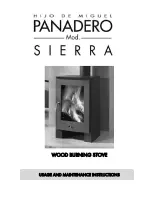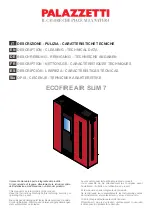
23
cod. 004777080 MBL - 08/2018 - Palazzetti - PN - Italy
Fig. 4
Fig. 3
Fig. 5
Fig. 2A
ENGLISH
Check the proper operation of the bearings annually
to keep the system ef
¿
cient.
When the
¿
re is lit, the door reaches high temperature;
use the glove supplied to open it.
The door features a
À
ap to clean the glass.
When loading wood into the hearth, the door must be
opened in two stages:
•
¿
rst slowly and partially (3-4 cm), to allow for the
smoke valve to open and the smoke in the hearth to
be sucked in by the
À
ue
• then completely, thus avoiding smoke escapes into
the environment.
1.2 CLEANING THE GLASS
The glass is cleaned using a damp cloth or some damp
paper dipped into the ash. To clean the glass, it is
necessary to open the
À
ap door by pulling the handle
outwards to release the closing pin on the top side of
the glass; once it has been released, open the door
by bringing it down with your hand to avoid crashing.
(Fig. 2).
The system allows the door to rotate downwards
and the opening is delimited by special stops, called
opening limiter arms.
Rub until the glass is clean.
You can also use detergents suitable for cleaning
kitchen ovens.
Do not clean the glass while the stove is on and do not
use abrasive sponges
1.3 AIR CLEANING GLASS REGISTER
POSITION
The position of the glass cleaning air register must be
referred to as follows (Fig. 2A):
• all closed for models W78F V10-W78F V11 (version
with O2 Ring)
• all open for W78F V12 models
(version without O2 Ring)
1.4 CLEANING THE INSIDE OF THE
HEARTH
SAFETY PRECAUTIONS
Before performing any maintenance operation, take
the following precautions:
A) Make sure that all the parts of the stove are cold.
B) Make sure that the ashes are completely
extinguished.
C) Use personal protective equipment provided for
by Directive 89/391/EEC.
D) Always use appropriate equipment for
maintenance.
Make sure that there are no combustion residues on
the grate, as they may obstruct the free passage of air.
Remove the grate and clean the hearth using a small
brush (not supplied). (Fig. 3)
Route the combustion residues into the ash pan, paying
















































